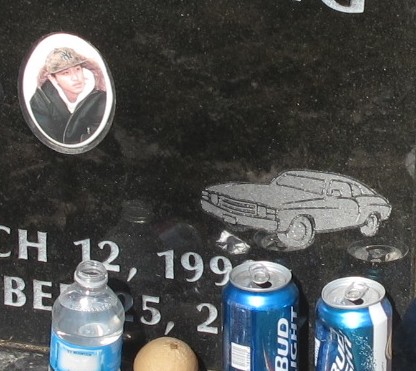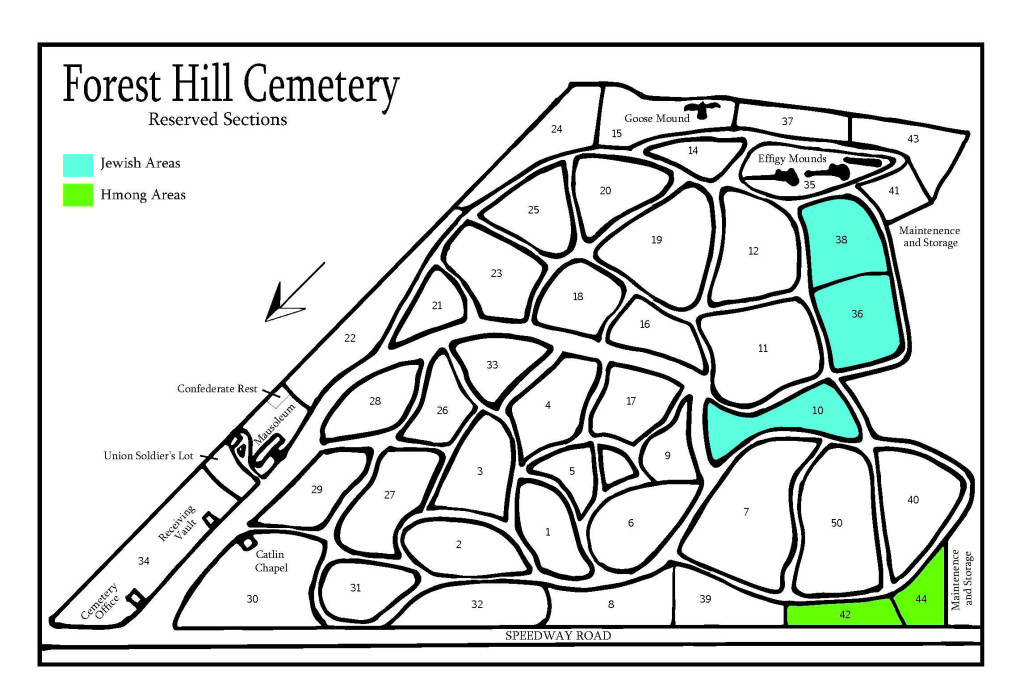The Hmong are an ethnic group originally from a mountainous region in China and Southeast Asia. In Madison, a great number of the Hmong community came from Laos as refugees during the Vietnam war, and after the 1990’s some of the Hmong immigrants came from Vietnam and China. Still today, most of the Hmong community in Madison consists of families originally from Laos. Hmong society is patrilineal, which means that their ancestors are traced through the line of male members of the family. Ancestors link Hmong people to a clan, which is very important as a source of identity and social interaction. Traditionally, a married woman derives her identity from her husband’s clan. After death, she becomes an ancestor in the family of her husband. In Southeast Asia as well as in America, there are Hmong who follow the Hmong way and keep their traditional beliefs and there are Hmong who follow Christian rites. Here we will talk about how Hmong who follow traditional beliefs experience the cemetery space.
Traditionally, Hmong believe that the universe has a land of light—the land of the living—and a land of darkness—the land of gods and ancestors. When a child is born, an ancestor is called from the land of the darkness to dwell in the newborn. In this sense, they believe in reincarnation, but not as a cycle from which one wants to set free—as in Hinduism or Buddhism—but as a cycle that one desires to be part of forever in order to perpetuate the linage of ancestry. Additionally, Hmong believe that in the body there are a number of souls; some say three souls others up to twelve. Regardless of the number, there are souls that are unstable (that might flee away and get us sick by doing so); there is a soul that becomes the ancestor; and a guardian soul that stays at the cemetery to guard the body. Many traditional Hmong thence, think of the cemetery as the ‘new home’ of the person who has died, so going to the cemetery becomes visiting family at the same time that it is remembering and paying respect to an ancestor.
The Hmong language professor at UW Madison, Choe Lee, explains how Hmong people honor they ancestors in the cemetery. There are specials days in which Hmong people will visit their dead such as New Year’s Eve and the birthday or the anniversary of death. However, ancestors might also “call” family members to ask for a visit. For example, an ancestor might appear in the dream of a person and ask for a visit and for food, and also when a person dreams of strong wind or rain it means that his/her ancestors are hungry. When you see a Hmong grave at Forest Hill cemetery that has cans of soda or actual food, what you are looking at is a meal that has been left there to take care of the guardian soul that stays at the cemetery. This soul has to be visited and fed by the descendants regularly. Moreover, these actions improve the well-being of the ancestor who lives in the world of darkness. In turn, an ancestor who is well cared for will give to the living many blessings in the land of light.
The ceremonies after death are also crucial for the well-being of the ancestor. It all starts with the quab ke or ‘showing the way’ at the funeral and ends with the tso plig or ‘releasing the soul’. A Hmong funeral in Madison normally will take 3 days and starts with the quab ke, which can last more than 4 hours. The older the person that has passed away was the longer this ceremony will take. The principal ceremony is the quab ke, in this ceremony a specially trained chanter will guide the soul to the land of darkness through his song. The songs show the dead how to pass obstacles and how to behave if anyone speaks to him/her in their trip. Professor Lee told us that there are two men trained as chanters in Madison. She also explained that during the three days of the ceremony, there is a sacrifice of a chicken for guidance—it is believed that the chicken can see the soul of the death and can also guide the deceased on his/her way—, and of a cow and a pig for prosperity. In addition, these days will be used to feed the souls, accompany the dead, settle his/her debts and for the burial. A burial in Madison, will normally take place under a tent where family and friends gather. There the dead is told to open his/her eyes and take a last look at the world of light. Then, people say good-bye and the coffin is placed in the ground. The release of the soul to be reborn does not normally happen in the moment of the burial. The tso plig might be done right away—especially in the case of a death occurring from an accident, to give the soul more time to heal—but normally people prefer to do it on New Year’s Eve because the beginning of a new year is an auspicious moment. The tso plig will also require of chanting and the gathering of the family, and it might be the moment where the headstone is placed.
After the completion of the ceremonies, the grave becomes the ‘new home’ of that person. The ‘new home’ is ornamented with a gravestone that usually has a story about the life of the dead person or a story about his/her family. It might also have symbols of things they used to like very much or possessions to which they were very attached, for example a car. In Forest Hill cemetery it is easy to find crosses, which signal the grave of a Christian Hmong, American flags, which most likely signal a the grave of a veteran or a person that enrolled in the army, and is also very common to see pictures carved in gravestones. Professor Lee tell us that in Southeast Asia it not common to see pictures on gravestones of Hmong people; it seems that this practice is a more modern way to visually enhance the ‘new home’ that is taking place here in America. The person that will usually take the ultimate decision on the design of the ‘new home’—as well as all other decisions surrounding the funeral and burial—is the older male member of the family, who is the one with more authority in a patrilineal society.
The place for the ‘new home’ of an ancestor needs to be chosen carefully. When a person dies the family will look for a mem toj for the burial. A mem toj is a location that will provide security to the dead and is traditionally a location surrounded by mountains. A good mem toj ensures a good new home and the well-being of the dead in the spirit world; it also ensures prosperity for the descendants of the deceased and for his/her next reincarnation. Professor Lee points out that “it is hard to find a good cemetery here in the States. You will here stories of Hmong people in Madison who take their dead to be buried in La Crosse, and you see the the city of La Crosse is surrounded by mountains so it is protected. That means the outsider can not make anything bad to them nor to their children.” In a way, a good mem toj is found through the reading of the landscape. Places that are half surrounded by mountains are also good for burial, but places with this attributes are hard to find. In the American context, it is more and more often to find families who choose available and convenient places even if they do not completely fit the ideal mem toj. Forest Hill cemetery seems to be one of the places that are more convenient than ideal; it would not be considered the safest place to be buried because it is not surrounded or partially by mountains.
printable map of the Hmong section
Back to Top | Traditions Main Page | Catholic and Lutheran Traditions | Jewish Traditions
note
For Hmong people death is a journey that connects with life not only because there is a rebirth but also because its rites tell the story of a person, of her/his clan and roots. Hmong funeral is to some extent a narration for remembering the person that has gone, and for bringing together the community and strengthen the sense of belonging to the clan. Cosmology is a fascinating and main part of Hmong culture that affects not only cemetery spaces and rituals surrounding death but also everyday life. If you are interested in knowing more about Hmong culture and Hmong cosmology you can find further information in the resources listed below.
resources
Catherine Falk. “Upon Meeting the Ancestors: the Hmong Funeral Ritual in Asia and Australia.” Hmong Studies Journal. 1:1 (1996), 1-15.
http://hmongstudies.com/HSJ-v1n1_Falk.pdf
Vincent K. Her. “Hmong Cosmology: Proposed Model, Preliminary Insights.” Hmong Studies Journal. 6:1 (2005), 1-25.
http://hmongstudies.org/HerHSJ6.pdf
Patricia V. Symonds. Calling in the Soul: Gender and the Cycle of Life in a Hmong Village. Seattle: University of Washington Press. 2004.









